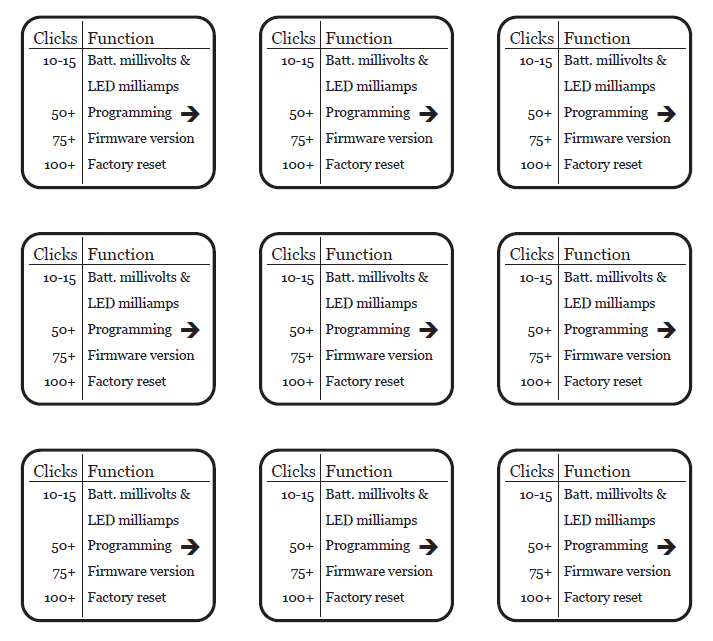The Leash Lantern utilizes a 15VP v4.8 driver, albeit with slightly different firmware options.
Instruction Manuals
Easy print & fold instruction manuals. Just print one out, fold it lengthwise, then width-wise to form a little 4-page book!
Instructional Video
Quick Reference Guide
Print out this double-sided PDF, cut out one of the guides, roll it around a AA battery, and insert it into the battery tube. Now anytime you want to customize your driver, you have the instructions readily available!

Special Functions
| Clicks | Light Show | Functionality |
| 10-15 | None | Flash out voltage and current |
| 50+ | Quick double-flash | Enter programming menu |
| 75+ | Low-High ramping | Flash out firmware version |
| 100+ | Furious flashing | Factory reset |
Voltage and Current Readout
Takes a reading at the current output level (this is important to note because battery voltage sags as LED current increases). Then flashes out the battery millivoltage followed by the LED current (in milliamps).
So if you tap 14x and keep the light on, the circuit might display:
1 flash – pause – 3 flashes – pause – 8 flashes – pause – quick flash (1.380 V)
– pause –
1 flash – pause – 5 flashes – pause – quick flash (150 mA)
Programming Menu
The programming menu is self-driven. If you enter it by accident, just let it finish (without turning the driver off) and it’ll exit all on its own. Only turn the driver off in the programming menu if you want to change a setting.
Turn the driver off while on a certain menu item to change that setting. When you turn the driver back on, it will re-enter the programming menu at that setting, and display the new value you’ve set.
| Setting | Light Show | Functionality |
| Output 1 Brightness | 1 blink | Select brightness from 24 values. |
| Crosswalk Timer | 2 blinks | Seconds at high output (15, 30, 45, 60) |
| Crosswalk Enabled | 3 blinks | Allow crosswalk mode (off, on) |
| Debounce | 4 blinks | Ignore accidental clicks (off, short, med, long) |
| Stepdown | 5 blinks | Stay in regulation (off, on) |
| Voltage Monitoring | 6 blinks | Monitor battery voltage (off, on) |
Brightness
For each output, choose the brightness from a ramp of 24 possible values. Turn the driver off and on to start ramping. Turn it off and on when you reach the desired output to save it. There is a double-blink at the top of the ramp to indicate when you’ve reached the highest setting, then it rolls back around to the bottom. Ramps twice. If you don’t turn it off at all during those two ramps, no changes are made to brightness.
Crosswalk Timer
How long the circuit should stay at high output for the crosswalk timer. Choose from 15, 30, 45, or 60s (1 – 4 blinks accordingly).
Debounce
Debounce determines whether the driver will ignore a tiny power outage, such as banging the host on a table and rattling the battery. Can be used to customize the “feel” of a mechanical switch to ensure only purposeful mode changes actually occur, while ignoring accidental ones.
| # Blinks | Debounce | Description |
| 1 | Off | All power outages count as a click. |
| 2 | Short | Tiny power outages ignored (couple milliseconds) |
| 3 | Medium | Brief power outages ignored (hundred or so milliseconds) |
| 4 | Long | Longer power outages ignored (few hundred milliseconds) |
Stepdown
Stepdown determines whether the driver will monitor LED current and attempt to stay in regulation (flat output). Maximizes runtime by intelligently decreasing output to prevent strain on the battery and LED.
| # Blinks | Setting | Description |
| 1 | Off | Does not check or stepdown |
| 2 | On | Steps down 2 output levels every 8 seconds until regulated |
Voltage Monitoring
Whether the circuit should monitor battery voltage and notify when it’s getting low. Advance warning of low battery before you set out into the dark.
| # Blinks | Setting | Description |
| 1 | Off | Do not monitor or notify when battery is low. |
| 2 | On | 2 quick blinks every 30s if battery < 0.95V (at current output) |
Firmware Version
Flashes out the current version of firmware installed on the driver. Different firmwares may behave differently, so this will help you identify which you have so you can find the appropriate documentation.
Flashes firmware numbers in the following pattern:
MAJOR – pause – MINOR – pause – REVISION
So if you click 75x on firmware version 4.8.1 it’ll display:
4 flashes – pause – 8 flashes – pause – 1 flashes
Factory Reset
Resets the driver to its delivered state. A last-ditch attempt to save a problematic driver, or a quick(ish) way to undo undesired programming changes.
Output Levels
For a white power LED (Nichia 219, Cree XP-L, etc) on firmware version 4.8.1, the 24 output levels in the ramp equal approximately the following LED currents:
| Ramp | 1 | 2 | 3 | 4 | 5 | 6 | 7 | 8 | 9 | 10 | 11 | 12 |
| Milliamps | 0.5 | 0.9 | 7 | 18 | 28 | 40 | 49 | 64 | 86 | 112 | 130 | 141 |
| Ramp | 13 | 14 | 15 | 16 | 17 | 18 | 19 | 20 | 21 | 22 | 23 | 24 |
| Milliamps | 160 | 188 | 205 | 230 | 250 | 263 | 283 | 297 | 312 | 335 | 363 | 389 |

